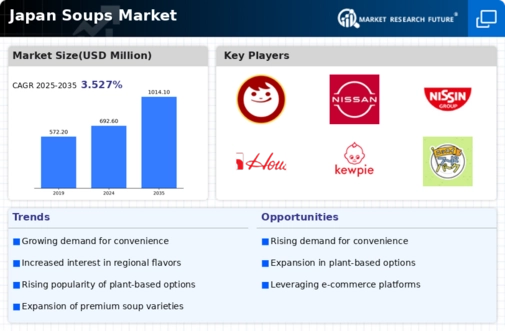Expansion of E-commerce Channels
The rise of e-commerce is reshaping the retail landscape for the soups market in Japan. With the increasing penetration of the internet and mobile devices, consumers are increasingly turning to online platforms for their grocery shopping. Recent statistics reveal that online grocery sales in Japan have surged by approximately 40% in the last year. This shift presents a significant opportunity for soup brands to reach a wider audience and enhance their distribution strategies. By leveraging e-commerce, companies can offer a diverse range of products, including specialty and gourmet soups that may not be available in traditional retail outlets. Furthermore, the convenience of online shopping aligns with the busy lifestyles of modern consumers, making it a crucial driver for growth in the soups market.
Rising Demand for Plant-Based Soups
The soups market in Japan is experiencing a notable shift towards plant-based options, driven by increasing health consciousness among consumers. As more individuals adopt vegetarian and vegan diets, the demand for plant-based soups is likely to rise. Recent data indicates that the plant-based food sector in Japan has grown by approximately 25% over the past two years. This trend suggests that manufacturers in the soups market must innovate to include diverse plant-based ingredients, catering to the evolving preferences of health-oriented consumers. Additionally, the growing awareness of environmental sustainability may further bolster the appeal of plant-based soups, as consumers seek products that align with their values. Consequently, this driver is expected to significantly influence the soups market, prompting brands to expand their offerings and enhance product visibility in retail channels.
Culinary Trends and Regional Flavors
The soups market in Japan is increasingly influenced by culinary trends that emphasize regional flavors and traditional recipes. As consumers seek authentic dining experiences, there is a growing interest in soups that reflect local ingredients and cooking methods. This trend is evident in the rising popularity of regional specialties, such as miso soup and tonjiru, which showcase the rich culinary heritage of Japan. Market Research Future indicates that products highlighting regional authenticity are likely to capture a larger share of the market, as consumers are willing to pay a premium for unique and culturally resonant offerings. Consequently, soup manufacturers may need to invest in sourcing local ingredients and promoting their products' cultural significance to capitalize on this driver within the soups market.
Increased Interest in Functional Foods
The concept of functional foods is gaining traction in Japan, particularly within the soups market. Consumers are increasingly seeking products that offer health benefits beyond basic nutrition. Soups fortified with vitamins, minerals, and probiotics are becoming more prevalent, as they cater to the growing demand for health-enhancing food options. Market analysis indicates that functional foods are projected to account for over 30% of the total food market in Japan by 2026. This trend suggests that soup manufacturers may need to reformulate existing products or develop new recipes that emphasize health benefits, thereby appealing to a broader audience. The integration of functional ingredients into soups could potentially enhance their marketability and consumer acceptance, positioning brands favorably in a competitive landscape.
Sustainability and Eco-Friendly Packaging
Sustainability is becoming a pivotal concern for consumers in Japan, influencing their purchasing decisions within the soups market. As awareness of environmental issues grows, there is a marked preference for products that utilize eco-friendly packaging and sustainable sourcing practices. Recent surveys indicate that approximately 60% of Japanese consumers are willing to pay more for products that are environmentally friendly. This trend suggests that soup manufacturers must prioritize sustainable practices, such as using recyclable materials and reducing carbon footprints in their production processes. By adopting eco-friendly initiatives, brands can enhance their appeal to environmentally conscious consumers, potentially leading to increased market share in the soups market. This driver underscores the importance of aligning product offerings with consumer values in a rapidly evolving marketplace.
















